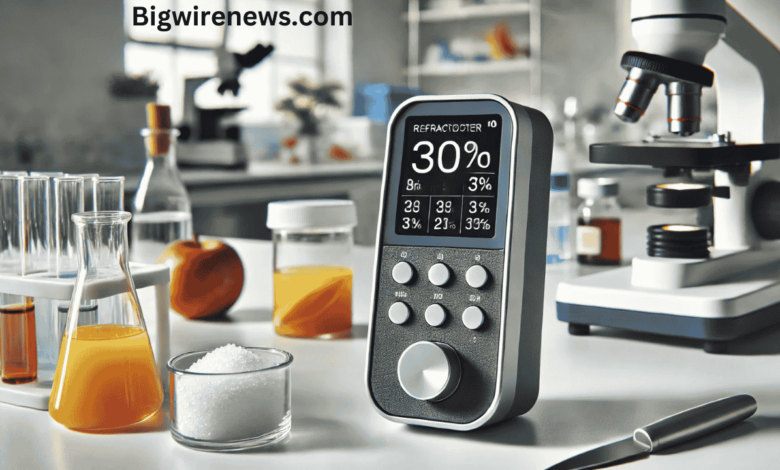Suki Digital Refractometer: A Comprehensive Guide to Precision Liquid Measurement

The Suki Digital Refractometer is a modern, versatile tool designed to measure the refractive index of liquids accurately. Widely used across industries such as food and beverage, agriculture, pharmaceuticals, and marine biology, it offers fast, reliable measurements for applications ranging from sugar concentration in beverages to salt levels in aquariums. This article will explore the key features, benefits, applications, and maintenance of the Suki Digital Refractometer, helping you understand its significance and why it’s a preferred choice for professionals and hobbyists.
What is a Suki Digital Refractometer?
A refractometer measures the refractive index, which indicates how light bends when passing through a liquid. The Suki Digital Refractometer utilizes digital technology to capture and convert light refraction data into digital readings on a high-resolution display, giving users fast and precise measurements. Unlike traditional analog models requiring manual interpretation, the Suki refractometer offers direct, easy-to-read results that minimize human error.
Key Features of the Suki Digital Refractometer
High Precision and Accuracy
The Suki Digital Refractometer delivers measurements with remarkable precision, often within ±0.1% Brix for sugar solutions. Equipped with advanced optical sensors, it accurately detects even minor changes in the refractive index. It is ideal for applications where even slight measurement deviations matter, such as pharmaceuticals and chemical testing.
Digital Display
This refractometer provides a precise digital readout, eliminating the need for users to interpret scales manually. This feature enhances readability and speed, making it ideal for high-volume testing environments where time is critical. The display also allows for readings in multiple units, including Brix for sugar content and refractive index for scientific measurements, offering flexibility across industries.
Automatic Temperature Compensation (ATC)
Temperature affects liquid density and can skew refractometer readings. The Suki Digital Refractometer includes automatic temperature compensation, ensuring that readings remain accurate even when liquid samples are slightly warmer or cooler than standard room temperature. This feature is crucial in industrial and laboratory settings where temperature fluctuations are ctypical.
Compact and Durable Design
The Suki Digital Refractometer is lightweight and portable, designed for laboratory and field use. Its durable casing protects it against wear and tear, making it suitable for rugged environments such as agricultural fields and aquaculture sites. Some water-resistant models allow users to work in humid or wet conditions without compromising the device’s functionality.
Data Logging and Connectivity
Specific Suki models offer data logging capabilities, enabling users to save multiple readings and export data to other devices for record-keeping and analysis. This feature is invaluable for quality control teams and researchers who need consistent, historical data for trend analysis.
Applications of the Suki Digital Refractometer
The versatility of the Suki Digital Refractometer allows it to be used across various sectors. Here are some of the most common applications:
Food and Beverage Industry
One of the primary uses of the Suki Digital Refractometer is in the food and beverage industry, particularly for measuring sugar content in products like juice, wine, beer, and soft drinks. The Brix scale is commonly used here, providing essential data on sugar concentration, which impacts flavor and shelf stability. In winemaking, it helps vintners assess grape ripeness and predict alcohol content.
Agriculture
In agriculture, refractometers are invaluable for evaluating the quality of crops, especially fruits and vegetables. Farmers can determine the ideal harvest time for peak sweetness by measuring the sugar levels in the produce. This data is also helpful for monitoring crop health, as high sugar indicates a robust, well-nourished plant.
Aquaculture and Marine Biology
The Suki Digital Refractometer also measures salinity levels in water, making it suitable for aquariums, fisheries, and marine biology research. Accurate salinity readings are crucial for maintaining healthy aquatic environments, as fish and other marine life are sensitive to changes in salt concentration.
Chemical and Pharmaceutical Industries
In these industries, refractometers are essential for quality control, ensuring the purity and concentration of solutions. For instance, in pharmaceutical production, active ingredients need precise concentration levels to ensure efficacy and safety. The Suki Digital Refractometer provides fast, non-destructive testing, making it a convenient choice for routine measurements.
Automotive Industry
In automotive applications, refractometers measure coolant and battery fluid concentrations. Proper coolant levels prevent engine overheating, while correct battery fluid concentrations are essential for vehicle safety and efficiency. Mechanics can ensure vehicles operate safely and reliablyby quickly checking fluid levels.
Benefits of Using a Suki Digital Refractometer
Enhanced Accuracy and Reliability
The Suki Digital Refractometer reduces human error through its digital display, providing accurate readings essential in quality-sensitive fields like pharmaceuticals and food production. This reliability boosts confidence in measurement results, leading to better-quality products and research outcomes.
User-Friendly Interface
The device is designed with simplicity, making it accessible to experienced technicians and beginners. The intuitive digital interface reduces the learning curve, enabling users to obtain accurate measurements without extensive training.
Fast and Efficient Measurement
Speed is critical in industrial and research settings, and the Suki Digital Refractometer excels by delivering results in seconds. This quick turnaround is especially beneficial in production environments where efficiency impacts profitability and workflow.
Adaptability Across Multiple Sectors
Thanks to its wide range of measurement capabilities, the Suki Digital Refractometer applies to diverse industries. Whether measuring sugar content in a vineyard or salt levels in a fishery, this refractometer meets varied needs, offering businesses a versatile tool to consolidate their measurement processes.
Maintenance Tips for the Suki Digital Refractometer
Proper maintenance is essential to ensure accurate readings and prolong the Suki Digital Refractometer’s lifespan. Here are some recommended practices:
- Regular Cleaning: After each use, clean the refractometer’s sensor and prism with a soft, damp cloth to prevent residue buildup. Avoid using abrasive materials that could scratch the optical components.
- Storage: Store the device in a dry, protective case to shield it from dust and moisture when not in use, especially if it’s used in fieldwork.
- Calibration: Frequent calibration is crucial for maintaining accuracy, mainly if the device is used extensively. Follow the manufacturer’s instructions for calibration intervals and procedures.
- Battery Check: Ensure the device’s batteries are charged or replaced as necessary to avoid disruptions during measurement sessions.
How to Use the Suki Digital Refractometer
- Prepare the Prism: Clean the prism with distilled water, then dry it with a soft cloth.
- Apply Sample: Place a few drops of the liquid sample onto the prism, ensuring it covers the entire surface to avoid air bubbles.
- Close the Daylight Plate: Close the lid over the sample to prevent external light interference.
- Take Measurement: Press the measurement button, and the device will display a digital reading within seconds.
- Record Results: Note the reading displayed on the screen. Repeat the process if necessary for consistency.
- Clean After Use: After each measurement, clean the prism to remove any residues that might impact future readings.
Why Choose the Suki Digital Refractometer?
The Suki Digital Refractometer offers significant advantages over traditional refractometers, including digital precision, faster readings, and a user-friendly interface. Its adaptability across multiple sectors and ease of maintenance make it an excellent investment for businesses and individuals alike. Users benefit from streamlined workflows, higher accuracy, and reduced measurement errors by choosing this digital model.
Conclusion
The Suki Digital Refractometer is indispensable for anyone requiring precise liquid concentration measurements. From winemakers monitoring sugar levels in grapes to marine biologists assessing salt concentrations, this versatile refractometer efficiently and accurately supports a wide range of applications. Its digital interface, automatic temperature compensation, and portability make it a modern solution that outshines traditional analog refractometers in every respect. Investing in a Suki Digital Refractometer means choosing quality, reliability, and advanced technology tailored to meet the demands of today’s fast-paced industries.




